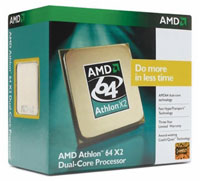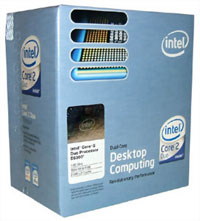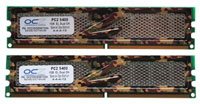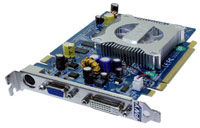Basic Midrange Configurations
We'll start with the Intel and AMD options for what we consider a basic midrange computer. These will offer good performance for a variety of tasks, but they are not tailored towards anything in particular. Before we get into the actual component lists, let's take a moment to clarify a few things. First, a lot of people certainly don't need all of the options we are listing below. Dual core processors are faster for some tasks, but there are still plenty of applications that run perfectly well on older systems, and they certainly don't need the processing power offered by a dual core CPU. Not everyone needs 2GB of memory, a discrete graphics card, a relatively large hard drive, etc. However, we are building what we consider to be a good all-around computer, and individualization can still be beneficial. If you're looking to cut costs a bit further, you can find additional information and advice in our last
Entry Level Buyer's Guide.
A second topic that we need to address is the question of AMD Athlon X2 versus Intel Core 2 Duo processors. If performance is your primary consideration, there are very few areas where Core 2 Duo isn't faster. Once you reach the Core 2 Duo E6600, it becomes faster than just about any official AMD Athlon X2 processor in overall performance, and the only way you will surpass its performance is with overclocking. When you start overclocking both platforms, however, Core 2 Duo is basically out of reach of AMD's current processor line. So Core 2 Duo is the way to go, right?
In actuality, AMD has done what most companies do when their product does not offer best in class performance: they cut prices, sometimes quite drastically. Motherboards for AMD systems also tend to be a bit less expensive than their Intel counterparts. The net result is that while Intel is undoubtedly the faster processor overall, AMD is very competitive - and perhaps even better - when it comes to price/performance. That goes double if you plan on getting a single core processor, as Intel doesn't offer any compelling single core solutions right now. We're sticking with dual core processors for our midrange and higher recommendations, but whichever way you choose to go the bottom line is that you can get a lot of performance without spending a ton of money, so try to spend your money where it will offer the most benefit.
| AMD Mid-Range Base System |
| Hardware |
Component |
Price |
Rebates |
| Processor |
Athlon 64 X2 3800+ AM2 (2x512K 2.0GHz) - Retail |
$133 |
|
| Motherboard |
DFI Infinity NF ULTRAII-M2 |
$95 |
|
| Memory |
OCZ S.O.E 2x1GB DDR2-667 (OCZ2SOE6672GK) |
$221 |
$30 |
| Video Card |
PNY GeForce 7600GS 256MB (VCG7600SXPB) |
$96 |
|
| Hard Drive |
Seagate 320GB SATA 3.0Gbps 7200RPM 16MB (Barracuda 7200.10) |
$90 |
|
| Optical Drive |
LG Black 18X DVD+R (GSAH22N-BK) |
$36 |
|
| Case |
Cooler Master Centurion 534 (RC-534-KKN2-GP) |
$66 |
$10 |
| Power Supply |
FSP Group (Fortron Source) 450W (AX450-PN) |
$62 |
|
| Display |
Acer AL2016W 20" 8ms (1680x1050) |
$233 |
|
| Speakers |
Logitech X-530 5.1 70W Speakers |
$74 |
|
| Keyboard and Mouse |
Microsoft Comfort Curve 2000 B2L-00047 |
$28 |
|
| Operating System |
Windows XP MCE 2005 (with Vista coupon) |
$115 |
|
| Bottom Line |
|
$1249 |
$1209 |
| Intel Mid-Range Base System |
| Hardware |
Component |
Price |
Rebates |
| Processor |
Intel Core 2 Duo E6300 (1.86GHz 2MB Shared) - Retail |
$185 |
|
| Motherboard |
Biostar TForce965PT (P965 775) |
$111 |
|
| Memory |
OCZ S.O.E 2x1GB DDR2-667 (OCZ2SOE6672GK) |
$221 |
$30 |
| Video Card |
PNY GeForce 7600GS 256MB (VCG7600SXPB) |
$96 |
|
| Hard Drive |
Seagate 320GB SATA 3.0Gbps 7200RPM 16MB (Barracuda 7200.10) |
$90 |
|
| Optical Drive |
LG Black 18X DVD+R (GSAH22N-BK) |
$36 |
|
| Case |
Cooler Master Centurion 534 (RC-534-KKN2-GP) |
$66 |
$10 |
| Power Supply |
FSP Group (Fortron Source) 450W (AX450-PN) |
$62 |
|
| Display |
Acer AL2016W 20" 8ms (1680x1050) |
$233 |
|
| Speakers |
Logitech X-530 5.1 70W Speakers |
$74 |
|
| Keyboard and Mouse |
Microsoft Comfort Curve 2000 B2L-00047 |
$28 |
|
| Operating System |
Windows XP MCE 2005 (with Vista coupon) |
$115 |
|
| Bottom Line |
|
$1317 |
$1277 |
 |
 |
For your typical midrange computer, we've gone with a selection of high-quality parts that offer a great price/performance ratio. With either of the above systems, you should easily be able to run all current applications, along with Windows Vista, with one possible exception: games. You can even run all current games, just not at maximum detail settings or high resolutions. The performance edge goes to the Intel E6300 build, but obviously the performance advantage comes with a pricing disadvantage. If you want to spend the same amount of money on both platforms, you could actually put an Athlon X2 4600+ into the AMD system and end up with typically better performance than the E6300. If you don't plan on stressing the CPU a lot, however, even an X2 3800+ on is more than sufficient. If you need more information about the various processors available, you may find it helpful to refer to our
Holiday CPU Guide.
The motherboard selections were chosen with an eye towards stability and cost without sacrificing performance. The AM2 motherboard actually uses the older NVIDIA nForce4 chipset, but we have found the performance and stability offered to be beyond reproach in the DFI motherboard. Likewise, the Biostar TForce 965PT is one of the most compelling P965 solutions currently available, offering good performance, stability, and features. Overclocking is also an option on either of these motherboards, and while they may not be the absolute best overclocking options around, they should be more than sufficient for the majority of users. Strictly in terms of features, the edge belongs to the DFI board, as it includes FireWire support. It is possible to get FireWire for socket 775 but it will usually require spending a bit more money than the Biostar board.
 |
Finding good DDR2 memory without spending a lot of money is still difficult, although prices have dropped quite a bit in the past several months. There are a few DDR2-800 offerings available that only cost a bit more money than DDR2-667, but with 5-5-5 timings instead and once you factor in mail-in rebates we feel that the OCZ S.O.E. (that's "Special Ops Edition" if you were wondering) DDR2-667 is probably the best option right now. It runs at 4-4-4 timings with 1.9V and shouldn't have any problem posting at 1.8V, and with a bit higher voltage you should be able to overclock to at least DDR2-800 (if you want to). We wouldn't go beyond about 2.1V for this memory, as that tends to be the safe limit for anything that doesn't use Micron D memory chips.
 |
The choice of graphics card is one of the more difficult decisions, but what is best is going to vary greatly by individual. The GeForce 7600 GS is a good entry level GPU, providing the features and performance necessary to accomplish most tasks. AMD's Radeon X1650 Pro offers a similar level of performance at a slightly higher price. Either one should work well, but if you need more options for graphics cards, check out our recent
Holiday GPU Guide.
Choosing among the different storage components these days usually ends up coming down to price as the deciding factor, as the performance offered is very close between the various brands. For the hard drives, we also factored in price per GB, and ended up with 320GB models being the best overall choices. Seagate and Western Digital are the least expensive brands and they both offer good performance and features, with Hitachi, Samsung, and Maxtor (who is now owned by Seagate) being the other major brands. The Western Digital 320GB Caviar SE16 and Seagate Barracuda 7200.10 320GB both cost around $90 and it's basically a tossup determining which is better. Both brands trade punches in benchmarks, coming in faster in some tests and slower in others; Seagate seems to do better in multimedia applications while Western Digital does better in multitasking scenarios, but in day-to-day use most people likely wouldn't be able to tell the difference.
















43 Comments
View All Comments
vailr - Friday, January 19, 2007 - link
Intel doesn't offer any compelling single core solutions right now.Consider the socket 775 Celeron D 356. When compared with an older Northwood P4 CPU of similar speed [~3.3 GHz at stock speed], it would seem to be a very good price/performance ratio upgrade. Tiger Direct has it for $50, after a $20 MIR. Combine with a VIA chip based motherboard, such as the ASRock Dual-VSTA or ECS P4M800 (or similar VIA board), which can also still re-use older DDR memory sticks and AGP video cards. Might even make an interesting basis for an Anandtech review, showing the "best bang for buck" upgrades, for a 2 or 3 year old system.
Some Celeron D 356 owners have also had excellent overclocking results (past 4 GHz), depending on the motherboard used.
mino - Saturday, January 20, 2007 - link
When compared with an older Northwood P4 CPUWell, the problem is A64 3200+ goes for $60.
$5 cheaper than 356...
LoneWolf15 - Friday, January 19, 2007 - link
At which resolutions? At 1920x1200, I think the 8800GTS would be the clear winner.
Also, I'd be interested to know how much difference there is between the Creative X-Fi ExtremeGamer, and the similarly priced (well, compared to your review, online I've seen it retailing slightly higher) X-Fi ExtremeAudio. The ExtremeAudio has the nicer gold-plated jacks; the ExtremeGamer actually is the first Creative card that I've seen that allows a user to plug in standard Intel-spec front panel audio. The card layouts are so different that I'm sure there has to be more differences than that; I'd like to know what those are.
uofahoefx - Friday, January 19, 2007 - link
If you are comparing price/performance I think the X2 4200+ would have been a better starting point. The performance difference between the 3800+ and E6300 is too significant to compare these systems.KorruptioN - Friday, January 19, 2007 - link
Whether or not the Rosewill 600W is really that much better than the Fotron Source 450W is debatableIt really is. I did some research as to who really was the OEM for this particular 600W Rosewill, and it turns out that the OEM is Solytech (the UL label on the PSU says E223918, Googling that brings me to http://www.jonnyguru.com/SMPS_UL.htm">this list, which then tells me Solytech). These guys are the new image for Deer electronics. If you've been around the hardware world for a while, you might know that Deer PSUs a few years back were notorious for being fire hazards, nothing better than doorstops. I still wouldn't trust them today. I think it was a poor choice for your guide.
For $71, you can get a much better PSU. Antec's http://www.newegg.com/Product/Product.asp?Item=N82...">TP3-430 is a good choice, and you'd be saving money. It's a Seasonic build, so you can be assured of high-efficiency, low-noise, and good power.
Operandi - Friday, January 19, 2007 - link
Your right Rosewill sucks. This guide would have been better served having recommended the entry level 450 watt Forton across the board since nothing here would be able to break 300 watts DC let alone 600 (assuming the Rosewill could even reach that point which itself is doubtful).About the Antec TP3; it is built buy Seasonic but it has also had corners cut to reach that price point -- it is not equal to Seasonic's own units. If you want Seasonic build quality get a Seasonic (or PCP&C Silencer or Crucial) if you want the best PSU to $$$ ratio it has to be this 400 watt http://www.ewiz.com/detail.php?name=PS-E5140GH">Enhance.
JarredWalton - Friday, January 19, 2007 - link
Despite the hard stance a lot of "informed enthusiasts" take on Rosewill, actual testing of a 500W unit by http://www.jonnyguru.com/review_details.php?id=48">JohnnyGuru.com turned in very favorable results. This is the same site that disliked the high ripple on the OCZ GameXStream 700W, FWIW (but still gave it a good review). I continue to think people are judging Rosewill without having actually tested/used any of their products. Are their QC standards as high as SeaSonic or some of the other top brands? Probably not, but outside of perhaps higher than normal DOA parts (which you just send back and get a new, working unit), they work very well in our experience.yyrkoon - Sunday, January 21, 2007 - link
Now, it is not the one being talked about here, but just yesterday, another IT friend of mine, got in his new thermaltake water cooled system case, and used a 350W Rosewill PSU to power up the water cooling portion (thankfully for him, his system board hadn't arrived yet), and while testing the cooling system a loud *pop* came from the the PSU, followed by a small 'billow' of smoke( he thinks he probably blew the top of a capacitor off, but didn't bother to look). The PSU continued to work for another 15 minutes according to him, but who knows what would have happened if this was powering a full system.Yeah, a 350W PSU, would not be powering an i680 system board, with a E6600, and dual 8800GTX's (which will be his finished system), but this speaks a lot for the manufacturer IMHO. Also, I've rarely seen a PSU take out more than just itself when dying, but it does happen. In my buddies case here, he intends on this system lasting him another 4-5 years, so, having an in-expencive PSU in the mix is not an option. One last thing, JonnyGuru mentions himself, that even while the Rosewill PSU in question does perform admirably, the choice of capacitors use in it, is questionable. Anyone who has been building systems for a awhile must realize that when components die in a computer system, there is a very good chance, it is because of the caps used on one component, or another, be it system board, or PSU. I myself am a big fan of ABIT, and even have had a system board from them die after 5-6 years, because of leaking / bad caps . . .
mostlyprudent - Saturday, January 20, 2007 - link
I have been personally very disappointed with my Rosewill PSU. I bought a 400W version about a year ago to replace the generic 350W that came with the case I used for the general family PC. The Rosewill is louder and less stable. I had recently bought an Fortron Source 380W for my office PC for a few $ more than the Rosewill and have been extremely pleased.Just thought I'd share my personal experience for what it is worth.
yyrkoon - Friday, January 19, 2007 - link
DO you seriously think any reseller / system integrator would recommend such a PSU ? I wouldn't. Anyone can make sly connotations one way, or another, but the simple fact is, we here have a reputation to uphold when building systems for 2nd parties, and would NEVER recommend such a PSU. Now if a customers wishes to shave costs by buying 'lesser' components, we just make sure they're informed of the possibilities, and leave it at that. It is not like every single 'cheap' PSU is garbage, most work fine, it is the ones you don't know about that creep up and bite you in the ass.
Another way to look at it is, you just dropped $1000 on a system, that will hopefully last at least a couple of years, whats another $100-$200 on a good, proven PSU? Perhaps if your computer means very little to *you* there is no harm done, when and if if fails, but I personally like the assurance that whatever I buy will be the best for the amount of money I've spent, and simply put, none of those parts would be made by Rosewill. An external USB HDD case ? sure, ok, fine, but never a PSU.